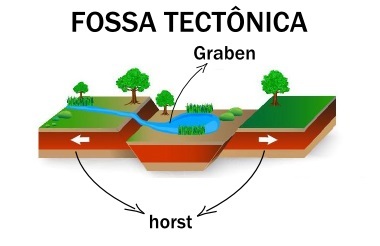At tectonic ditches are relief forms constituted by the spacing between two tectonic plates, which causes the formation of a low-altitude relief zone, that is, a relative depression, called in this case in graben. The regions that are positioned around this graben are called horst and show elevations in relation to the terrain around them, as can be seen in the following diagram:

Explanatory scheme for the formation of tectonic trenches
It is important not to confuse tectonic pits with ocean trenches. The latter are positioned, as the name suggests, in areas of the oceans and are usually deeper and more unstable, located in the border zones between two tectonic plates. An example is the Mariana Trench, possibly the deepest point in the Earth's relief.
The formation of tectonic trenches is related to the occurrence of geological faults and the removal of their tectonic plates. An example is the Rift Valley, in Africa, which has a large extension and which originated millions of years ago due to the distance between the African and Arabic plates. This valley constitutes a broad relative depression and is positioned over a series of geological faults.
There are also cases of tectonic pits in Brazil. We can mention, for example, the Vale do Paraíba and the Recôncavo Baiano trenches, on which formed sedimentary basins, given that these depression zones are favorable for the accumulation of sediments. In the case of the Recôncavo, the process favored the formation of oil, which is economically exploited.
It is important to consider that in tectonic pits, especially those called “rifts”, there is an abundance of granitic rocks, among other types of plutonic igneous rocks. This is because the shifting of the plates, with the formation of the valleys, eventually results in the rise of the internal magma, causing it to solidify in non-volcanic processes.

Vale do Paraíba, in the background, seen from the top of Pico de Itapeva (SP) *
The formation of tectonic trenches is evidence of how dynamic the earth's relief is, in addition to showing that the actions of the tectonism interfere greatly in the earth's surface and, consequently, in the formation and development of societies.
__________________
* Image credits: Rodrigo Soldon / Wikimedia Commons
By Rodolfo Alves Pena
Master in Geography
Source: Brazil School - https://brasilescola.uol.com.br/geografia/fossas-tectonicas.htm
